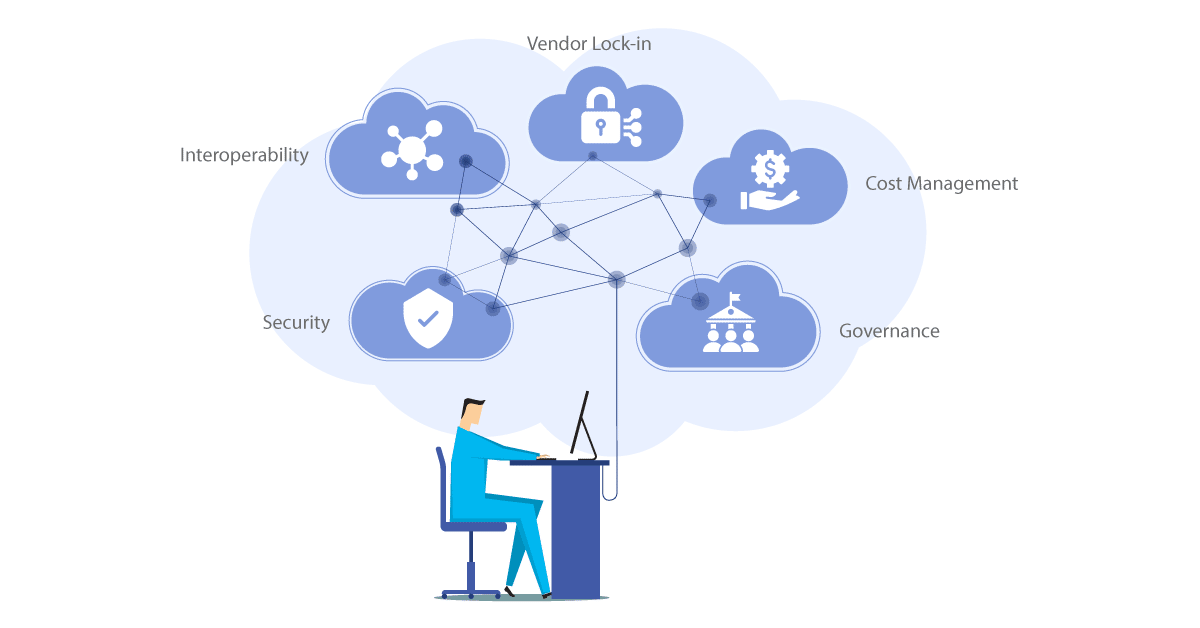Multi-cloud is the use of two or more public cloud vendors to provide infrastructure, SaaS, or PaaS services. It has several benefits over using a single cloud provider, including harnessing the individual strengths of each cloud provider, avoiding vendor lock-in, and increased security and resiliency. Multi-cloud allows companies to choose the best cloud providers for each task, giving them the freedom to access multiple options, which can give the best match for various parts of the company. Companies can also avoid the lock-in effect that arises when using only one cloud provider. Multi-cloud also provides the ability to choose a cloud service that best meets company needs at the lowest possible cost.
Aonflow iPaaS – Free for First 3 Months!
Build and run up to 1,500 transactions monthly with no cost. No payment info needed!
The Modern Cloud Approaches
When public cloud providers such as AWS, Azure, and others started to be the infrastructure providers for SaaS, the need for the system to cooperate from cloud to ground arose. The term “ground” refers to the data service center or private cloud provider that already existed. Hybrid cloud solutions, which combine data centers or private cloud and public cloud, were introduced. Hybridness is often achieved through distributed execution architecture, where the development and monitoring are done via a centralized UI, and the execution is separated in an individually deployable “engine.” Execution engines can then be deployed in the cloud or ground.
Edge computing, a public cloud solution where the computational power is brought close to the place where it is needed, solved capacity issues of video streaming. Some public cloud vendors also offer localized or country-specific services like file storage.
Why multi-cloud?
Harness the individual strengths of each cloud provider
Multi-cloud allows companies to adapt their business needs to the best cloud providers for each task. For example, one cloud provider can offer local edge services, which help keep up with regulations like GDPR or other governmental rules like “data must not leave the border of our country.” By choosing several cloud providers, companies can take advantage of the best of what each one has to offer and mix and match services to fit their applications, workloads, and tools. Different businesses might have different demands, and even if a global platform might be ideal for parts of the operation, smaller and local cloud providers may very well be the ideal solution for another.
Avoid A Cloud Vendor Lock-In
Multi-cloud is also useful for avoiding the lock-in effect that arises when using only one cloud provider. If all applications are built to work on a specific cloud platform, the company will also be bound by that platform, making it more difficult to make a change at a later stage. By using multi-cloud from the start, developers can build apps that work on multiple platforms, giving companies maximum flexibility to take advantage of the best price, image, or performance of various platforms. By avoiding lock-in, companies gain a better opportunity to optimize costs and performance.
Increased Resiliency And Security
Another significant advantage of using multi-cloud is increased security and resiliency. If you choose to overlap specific infrastructure and backups in two or more public clouds, you are better prepared for the unthinkable, such as a vendor-wide outage or a security breach. This way, you won’t lose all your data in case of an incident.
Furthermore, using several public clouds also enables you to achieve better resilience in the event of a disaster or cyber-attack. If one cloud provider goes down or gets hacked, you can still access your data from another cloud provider.
By overlapping specific infrastructure and backups (files and services) in two public clouds, companies are better prepared for the unthinkable, such as big cloud vendor-wide outages. multi-cloud also allows companies to distribute their workloads across different clouds, reducing the risk of data loss or downtime if one cloud experiences problems.
Aonflow is the leading integration platform.
You can kick-start by integrating your first-ever workflow in just a matter of minutes.
How a Modern Integration Platform helps with Multi-Cloud
Hybrid cloud solutions, which combine data center or private cloud and public cloud, are often achieved through distributed execution architecture, where the development and monitoring are done via a centralized UI, and the execution is separated in an individually deployable “engine.” Execution engines can then be deployed in the cloud or ground. A modern integration platform helps with multi-cloud by enabling distributed execution of integration flows across multiple clouds and ground infrastructure. The platform can manage the complexities of multi-cloud deployments and make it easier to integrate different cloud platforms. The platform can also provide a centralized monitoring and management system, giving companies an overview of all integration flows and connections across the various clouds and ground infrastructure.
Additionally, modern integration platforms typically offer pre-built connectors and APIs to various cloud platforms, allowing companies to easily connect and integrate with popular cloud services like AWS, Azure, Google Cloud, and others. This reduces the development time and complexity required for integrating different cloud services.
Another key feature of modern integration platforms is their ability to provide security and compliance capabilities across multi-cloud deployments. They can ensure data privacy and security, prevent unauthorized access, and manage compliance requirements across different cloud environments.
Another way a modern integration platform helps with multi-cloud is by providing a unified API layer that abstracts the differences between various cloud provider APIs. This allows for seamless integration between different cloud providers, reducing the amount of time and effort required to manage multiple cloud providers. With a unified API layer, developers can work with a consistent set of APIs, regardless of the underlying cloud infrastructure.
In addition, a modern integration platform can also provide a range of integration patterns and connectors that support the integration of different cloud applications and services. For example, the platform can include pre-built connectors for popular cloud applications such as Salesforce, ServiceNow, and Workday, allowing users to quickly and easily integrate these applications with other cloud services. This reduces the need for custom integration development, which can be time-consuming and costly.
Another advantage of a modern integration platform for multi-cloud is its ability to provide real-time data synchronization and replication across different cloud environments. This allows businesses to maintain a consistent view of data across all their cloud providers, which is crucial for maintaining data accuracy and integrity. For example, a business might have customer data in one cloud provider and financial data in another. By using a modern integration platform, the business can ensure that both sets of data are kept in sync in real-time, regardless of which cloud provider they are stored in.
In addition, a modern integration platform can help businesses to meet compliance requirements for data protection and privacy. With data increasingly being stored and processed across multiple cloud providers, it can be challenging to ensure that data is kept secure and compliant with relevant regulations such as GDPR, HIPAA, or CCPA. A modern integration platform can provide a range of security and compliance features, such as encryption, access control, and audit trails, to help businesses meet these requirements.
A modern integration platform helps companies leverage the benefits of multi-cloud while managing the complexities that come with it. It provides a centralized and streamlined approach to integrating multiple clouds and ground infrastructure, reduces development time and complexity, and ensures security and compliance across different cloud environments.
Multi-cloud Challenges
Multicloud environments have become increasingly popular due to the benefits they offer, such as cost efficiency, scalability, and flexibility. However, they also present several challenges that need to be addressed. One of the main challenges of multi-cloud is complexity. With multiple cloud platforms, each with its own management tools and APIs, managing the entire system can be overwhelming. It requires specialized skills and expertise, which may not be available in-house, resulting in increased operational costs.
Security
With multiple clouds and numerous entry points, security becomes a critical concern. Each cloud provider has its own security protocols and standards, and maintaining consistent security across all clouds can be a daunting task. Misconfigurations or vulnerabilities in one cloud could potentially compromise the entire system. It is essential to implement a comprehensive security strategy that covers all clouds and ensures consistent security across all platforms.
Interoperability
Each cloud provider has its own set of APIs and protocols, making it difficult to integrate different clouds. Application integration across multiple clouds requires careful planning and implementation, and it can be time-consuming and costly. Interoperability issues can also affect the performance and reliability of the entire system.
Vendor Lock-in
When a company uses a single cloud provider, it can become dependent on that provider, making it difficult to switch to another provider in the future. With multiple clouds, vendor lock-in can be reduced, but it requires careful planning and implementation. Companies must ensure that they can easily move their data and applications between different clouds without losing functionality or performance.
Cost Management
While multi-cloud can be cost-efficient, managing costs across multiple clouds can be challenging. Each cloud provider has its own pricing model, and it can be difficult to compare prices and optimize costs. Companies need to implement a comprehensive cost management strategy that covers all clouds and ensures cost efficiency across all platforms.
Governance
With multiple clouds and complex system architectures, it can be difficult to maintain compliance and regulatory requirements. Companies need to ensure that they have a comprehensive governance strategy that covers all clouds and ensures compliance across all platforms.
Multi-cloud environments present several challenges that need to be addressed. By addressing these challenges, companies can reap the benefits of multi-cloud, such as cost efficiency, scalability, and flexibility, while minimizing the risks and challenges associated with this approach.
Final Thoughts
Multi-cloud is a powerful approach that can help you optimize your cloud investments, achieve better performance, security, and resilience, and avoid the lock-in effect. However, multi-cloud also poses challenges in terms of complexity, data integration, and management overhead. To overcome these challenges, you need a modern integration platform that can provide a unified view of your entire cloud infrastructure and enable seamless integration, collaboration, and data management across different clouds. With a modern integration platform, you can streamline your multi-cloud operations and make the most of your cloud investments.
A can also help businesses to optimize their multi-cloud deployments by providing insights and analytics into integration performance and usage. By monitoring integration flows across different cloud providers, the platform can identify bottlenecks and performance issues, allowing businesses to optimize their deployments for better performance and cost-effectiveness. The platform can also provide usage analytics, allowing businesses to identify which integrations are being used most frequently and which are not, enabling them to make informed decisions about which integrations to prioritize.
In summary, a modern integration platform can provide a range of benefits for businesses looking to deploy multi-cloud solutions. By enabling distributed execution of integration flows, providing a unified API layer, supporting a range of integration patterns and connectors, providing real-time data synchronization and replication, ensuring compliance with data protection and privacy regulations, and providing insights and analytics into integration performance and usage, a modern integration platform can help businesses to optimize their multi-cloud deployments for better performance, scalability, and cost-effectiveness.
Aonflow iPaaS – Free for First 3 Months!
Build and run up to 1,500 transactions monthly with no cost. No payment info needed!


